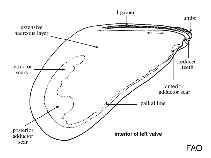Mytilus californianus Conrad, 1837
California mussel| Native range | All suitable habitat | Point map | Year 2050 |

|
| This map was computer-generated and has not yet been reviewed. |
| Mytilus californianus AquaMaps Data sources: GBIF OBIS |
Upload your photos
Google image | No image available for this species;
drawing shows typical species in Mytilidae.
Google image | No image available for this species;
drawing shows typical species in Mytilidae.
Classification / Names Common names | Synonyms | CoL | ITIS | WoRMS
Bivalvia | Mytilida | Mytilidae
Environment: milieu / climate zone / depth range / distribution range Ecology
Benthic; depth range 0 - 100 m (Ref. 95344), usually 0 - 30 m (Ref. 104320). Temperate; 62°N - 18°N, 180°W - 109°W
Distribution Countries | FAO areas | Ecosystems | Occurrences | Introductions
Eastern Pacific: from Aleutian Islands, Alaska, USA to Baja California and Isla Socorro, Mexico. Subtropical to boreal.
Length at first maturity / Size / Weight / Age
Maturity: Lm ? range ? - ? cm Max length : 25.5 cm TL male/unsexed; (Ref. 95344); common length : 20.0 cm TL male/unsexed; (Ref. 312)
Short description Morphology
Shell with blue, black and irregular groove lines. Often create dense mats. Mats can form habitats for more than 100 other species (Ref. 312).
It has a shell length of 20 cm long (Ref. 312). Found in dense colonies on wharf piles and surf exposed rocks in the mid to high tide zone. Its diet include fine organic detritus, living plankton, especially dinoflagellates; when the water exceeds a certain temperature, often from late May through October, mussels feed on dinoflagellates that make them poisonous for humans to eat (Ref. 312). Very dominant competitor in an intertidal bed. Prefers to settle on other mussels and barnacles, giving it a competitive advantage (Ref. 104225). Predators are ochre star, dogwinkle, and humans (Ref. 312). Occurs from mid to high tide mark (Ref. 312).
Life cycle and mating behavior Maturity | Reproduction | Spawning | Eggs | Fecundity | Larvae
Life cycle: Egg develops into the first free-swimming larval stage (trocophore) within 4 to 24 hours, afterwhich it develops into a veliger larvae within 24 to 48 hours. The veliger secretes the first larval shell within 10 to 12 hours, which then develops into a velichoncha larvae which secretes the second larval shell. It further develops into pediveliger, with a characterized foot making it mobile to find a suitable substrate and able to feed. It metamorphoses into a post-larval mussel called plantigrade (Ref. 104799).
Main reference
References | Coordinator | Collaborators
Gallivan, G. and J. Danforth. 1999. (Ref. 312)
IUCN Red List Status
(Ref. 130435: Version 2024-2)
CITES status (Ref. 108899)
Not Evaluated
CMS (Ref. 116361)
Not Evaluated
Threat to humans
Human uses
Fisheries: commercial
| FishSource | Sea Around Us
Tools
More information
Trophic Ecology
Ecology
Population dynamics
Growth
Max. ages / sizes
Length-weight rel.
Length-length rel.
Length-frequencies
Mass conversion
Recruitment
Abundance
Max. ages / sizes
Length-weight rel.
Length-length rel.
Length-frequencies
Mass conversion
Recruitment
Abundance
Life cycle
Distribution
Human Related
Aquaculture profiles
Stamps, coins, misc.
Stamps, coins, misc.
Outreach
References
Internet sources
BHL | BOLD Systems | CISTI | DiscoverLife | FAO(Publication : search) | Fishipedia | GenBank (genome, nucleotide) | GloBI | Gomexsi | Google Books | Google Scholar | Google | PubMed | Tree of Life | Wikipedia (Go, Search) | Zoological Record
Estimates based on models
Preferred temperature
(Ref. 115969): 8.6 - 14.3, mean 10.1 (based on 140 cells).



